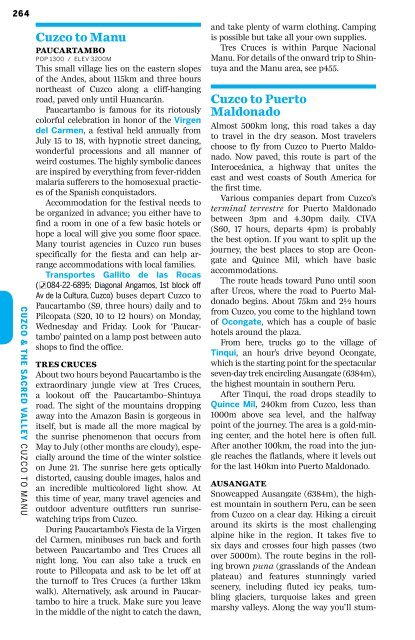peru-8-cuzco-sacred-valley
Create successful ePaper yourself
Turn your PDF publications into a flip-book with our unique Google optimized e-Paper software.
264<br />
Cuzco & the Sacred Valley T C H u E zC H O I K TO E T M H A E N U J U N G L E<br />
Cuzco to Manu<br />
PAUCARTAMBO<br />
POP 1300 / ELEV 3200M<br />
This small village lies on the eastern slopes<br />
of the Andes, about 115km and three hours<br />
northeast of Cuzco along a cliff-hanging<br />
road, paved only until Huancarán.<br />
Paucartambo is famous for its riotously<br />
colorful celebration in honor of the Virgen<br />
del Carmen, a festival held annually from<br />
July 15 to 18, with hypnotic street dancing,<br />
wonderful processions and all manner of<br />
weird costumes. The highly symbolic dances<br />
are inspired by everything from fever-ridden<br />
malaria sufferers to the homosexual practices<br />
of the Spanish conquistadors.<br />
Accommodation for the festival needs to<br />
be organized in advance; you either have to<br />
find a room in one of a few basic hotels or<br />
hope a local will give you some floor space.<br />
Many tourist agencies in Cuzco run buses<br />
specifically for the fiesta and can help arrange<br />
accommodations with local families.<br />
Transportes Gallito de las Rocas<br />
(%084-22-6895; Diagonal Angamos, 1st block off<br />
Av de la Cultura, Cuzco) buses depart Cuzco to<br />
Paucartambo (S9, three hours) daily and to<br />
Pilcopata (S20, 10 to 12 hours) on Monday,<br />
Wednesday and Friday. Look for ‘Paucartambo’<br />
painted on a lamp post between auto<br />
shops to find the office.<br />
TRES CRUCES<br />
About two hours beyond Paucartambo is the<br />
extraordinary jungle view at Tres Cruces,<br />
a lookout off the Paucartambo–Shintuya<br />
road. The sight of the mountains dropping<br />
away into the Amazon Basin is gorgeous in<br />
itself, but is made all the more magical by<br />
the sunrise phenomenon that occurs from<br />
May to July (other months are cloudy), especially<br />
around the time of the winter solstice<br />
on June 21. The sunrise here gets optically<br />
distorted, causing double images, halos and<br />
an incredible multicolored light show. At<br />
this time of year, many travel agencies and<br />
outdoor adventure outfitters run sunrisewatching<br />
trips from Cuzco.<br />
During Paucartambo’s Fiesta de la Virgen<br />
del Carmen, minibuses run back and forth<br />
between Paucartambo and Tres Cruces all<br />
night long. You can also take a truck en<br />
route to Pillcopata and ask to be let off at<br />
the turnoff to Tres Cruces (a further 13km<br />
walk). Alternatively, ask around in Paucartambo<br />
to hire a truck. Make sure you leave<br />
in the middle of the night to catch the dawn,<br />
and take plenty of warm clothing. Camping<br />
is possible but take all your own supplies.<br />
Tres Cruces is within Parque Nacional<br />
Manu. For details of the onward trip to Shintuya<br />
and the Manu area, see p455.<br />
Cuzco to Puerto<br />
Maldonado<br />
Almost 500km long, this road takes a day<br />
to travel in the dry season. Most travelers<br />
choose to fly from Cuzco to Puerto Maldonado.<br />
Now paved, this route is part of the<br />
Interoceánica, a highway that unites the<br />
east and west coasts of South America for<br />
the first time.<br />
Various companies depart from Cuzco’s<br />
terminal terrestre for Puerto Maldonado<br />
between 3pm and 4.30pm daily. CIVA<br />
(S60, 17 hours, departs 4pm) is probably<br />
the best option. If you want to split up the<br />
journey, the best places to stop are Ocongate<br />
and Quince Mil, which have basic<br />
accommodations.<br />
The route heads toward Puno until soon<br />
after Urcos, where the road to Puerto Maldonado<br />
begins. About 75km and 2½ hours<br />
from Cuzco, you come to the highland town<br />
of Ocongate, which has a couple of basic<br />
hotels around the plaza.<br />
From here, trucks go to the village of<br />
Tinqui, an hour’s drive beyond Ocongate,<br />
which is the starting point for the spectacular<br />
seven-day trek encircling Ausangate (6384m),<br />
the highest mountain in southern Peru.<br />
After Tinqui, the road drops steadily to<br />
Quince Mil, 240km from Cuzco, less than<br />
1000m above sea level, and the halfway<br />
point of the journey. The area is a gold-mining<br />
center, and the hotel here is often full.<br />
After another 100km, the road into the jungle<br />
reaches the flatlands, where it levels out<br />
for the last 140km into Puerto Maldonado.<br />
AUSANGATE<br />
Snowcapped Ausangate (6384m), the highest<br />
mountain in southern Peru, can be seen<br />
from Cuzco on a clear day. Hiking a circuit<br />
around its skirts is the most challenging<br />
alpine hike in the region. It takes five to<br />
six days and crosses four high passes (two<br />
over 5000m). The route begins in the rolling<br />
brown puna (grasslands of the Andean<br />
plateau) and features stunningly varied<br />
scenery, including fluted icy peaks, tumbling<br />
glaciers, turquoise lakes and green<br />
marshy <strong>valley</strong>s. Along the way you’ll stum-


